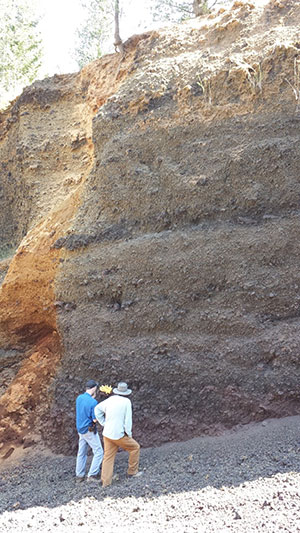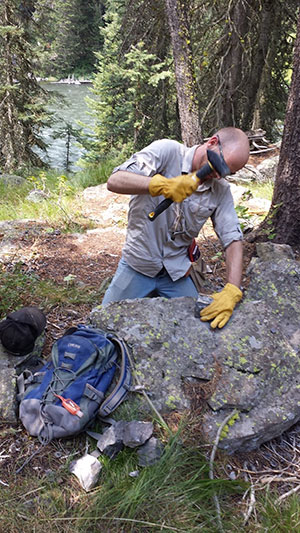UW and USGS Science Team Discover Temporal Relationship Between Basaltic Volcanism and Yellowstone’s Rhyolitic Eruptions
Published April 25, 2025

Kenneth Sims and other research scientists recently discovered that mafic volcanism of Henrys Fork Caldera -- located in eastern Idaho and west of Yellowstone National Park -- occurred concurrently with second- and third-cycle rhyolite volcanism in and around the Yellowstone caldera.
The revelation, detailed in a recently published paper, helps provide a new and younger timeline of volcanic activity in the Henrys Fork Caldera region and adds knowledge to the chronology of mafic eruptions and their temporal relation to rhyolitic volcanism in the Yellowstone Plateau volcanic field, of which little was previously known.
“Essentially, it changes our understanding of the Yellowstone magmatic system by showing how basaltic eruptions have ‘thermally primed’ Yellowstone's big caldera-forming eruptions and shows that there are some very young eruptions in the Henrys Fork Caldera,” says Sims, a University of Wyoming professor of geology and geophysics and a member of the United States Geological Survey (USGS) Yellowstone Volcano Observatory.
Sims was second author of a paper titled “New 40Ar/39Ar eruption ages reveal an important temporal relationship between mafic and silicic volcanism in the Yellowstone Plateau volcanic field” that appeared in this month’s print edition of the journal Geology.
Geology, the journal of the Geological Society of America, features rapid publication of about 23 refereed four-page papers each month. Articles cover all Earth science disciplines and include new investigations and provocative topics.
Cole Messa, a former Ph.D. student under Sims in UW’s Wyoming High Precision Isotope Laboratory, and now a research professional in the School of Energy Resources, was the paper’s lead author. Other contributors to the paper were Brandi Lawler, a UW Ph.D. student in geology and geophysics; Mark Stelton, a scientist with the USGS Volcano Center in Moffett Field, Calif.; and Mel Kuntz, a research geologist with the USGS in Denver.
To address the information gap in understanding volcanism in Yellowstone, the research team collected 13 samples of 40Ar/39Ar eruption ages from mafic lava flows of the Henrys Fork Caldera region, according to the paper. A mafic volcanic eruption is one characterized by lava flows low in silica and high in iron and magnesium. Rhyolitic lava flows are viscous in nature and form lava domes that are thick and blocky. Yellowstone’s caldera forming super-eruptions also are rhyolitic in composition.
This study produced a timeline of volcanic activity in Henrys Fork Caldera and related it to volcanic eruptions linked to Yellowstone’s most recent caldera-forming cycle, the paper says. The new timeline determined that extra-caldera mafic volcanism in Henrys Fork Caldera frequently followed rhyolitic volcanism in Yellowstone caldera.

“These periods of increased activity in the lower portion of the magmatic system are manifested on the surface as periods where numerous basaltic magmas erupt outside the caldera while rhyolites, which are less dense, ‘block’ the basalt from rising where a rhyolite magma chamber is present -- namely in the Yellowstone caldera -- but may erupt themselves,” Sims says. “This explains why Yellowstone caldera is characterized by numerous episodes of rhyolite lava flow activity that correlate in time with basaltic activity outside of the caldera.”
Another striking conclusion from the new research is the identification of a basalt eruption that is just 35,000 years old located in the Henrys Fork Caldera region, Sims says. Previously, it was thought that the youngest eruption in the region was the rhyolite lava of the Pitchstone Plateau about 70,000 years ago, while the youngest known basalt flow was 120,000 years old.
“The new result means that this 35,000-year-old basalt is now the youngest Yellowstone eruption known,” Sims says. “The younger age implies that basaltic activity remains possible west of Yellowstone National Park, and that the deeper, basaltic portion of Yellowstone’s magmatic system has been active since the last known eruption of rhyolite at Yellowstone.”
The results of this study also were highlighted in the Yellowstone Volcano Observatory’s Caldera Chronicles here.
The study was funded by the Wyoming National Aeronautics and Space Administration Space Grant Consortium, USGS Jack Kleinman Grants for Volcano Research, the Wyoming Geological Association and the Tobacco Root Geological Society.

